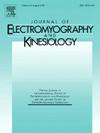Does the rate of hip abductor and adductor muscle activation during weight transfer influence voluntary lateral stepping in chronic stroke?
IF 2.3
4区 医学
Q3 NEUROSCIENCES
引用次数: 0
Abstract
People with chronic stroke (PwCS) suffer from impaired lateral weight transfer, resulting in a loss of balance. The primary purpose of this study was to examine how stroke impairs the rate of hip abductor-adductor muscle activation during weight transfer compared to controls, and whether this influences subsequent stepping performance. The secondary purpose was to determine how stroke affects bilateral coordinated hip abductor-adductor muscle activity between the step and stance legs. 20 PwCS (61.6 ± 7.4 years, 4F/16 M) and 10 healthy controls (64.8 ± 8.9 years, 5F/5M) were included. Participants took a voluntary lateral step, as quickly as possible, in response to a light cue. Bilateral Adductor Longus (ADD) and Gluteus Medius (GM) rate of muscle activation (RoA) were measured using electromyography, and spatiotemporal step characteristics were measured using motion capture. Paretic (p < 0.01) and non-paretic (p < 0.01) stance and step legs had a reduced GM and ADD RoA during weight transfer compared to controls. Reduced stance and step GM and ADD RoA were associated with longer weight transfer and step initiation times (rs = − 0.47 to – 0.63, p < 0.001). PwCS had a lack of bilateral coordinated GM and ADD activity (p > 0.05). Post-stroke reductions in GM and ADD RoA contribute to altered step characteristics.
体重转移过程中髋外展肌和内收肌的激活率是否影响慢性卒中患者的随意外侧行走?
慢性中风(PwCS)患者的侧身重量转移受损,导致失去平衡。本研究的主要目的是研究与对照组相比,中风如何影响体重转移过程中髋外展-内收肌的激活率,以及这是否会影响随后的步进表现。次要目的是确定中风如何影响双侧步腿和站立腿之间协调的髋关节外展-内收肌活动。纳入20例PwCS(61.6±7.4岁,4F/16 M)和10例健康对照(64.8±8.9岁,5F/5M)。参与者在灯光的提示下,尽可能快地主动采取横向动作。采用肌电法测量双侧长内收肌(ADD)和臀中肌(GM)的肌肉激活率(RoA),采用动作捕捉法测量时空步长特征。轻瘫(p <;0.01)和非父母(p <;与对照组相比,体重转移过程中站立和步腿的GM和ADD RoA降低。减少的姿态和步数GM和ADD RoA与较长的体重转移和步数起始时间相关(rs = - 0.47至- 0.63,p <;0.001)。PwCS缺乏双边协调的GM和ADD活动(p >;0.05)。卒中后GM和ADD RoA的减少有助于改变步特征。
本文章由计算机程序翻译,如有差异,请以英文原文为准。
求助全文
约1分钟内获得全文
求助全文
来源期刊
CiteScore
4.70
自引率
8.00%
发文量
70
审稿时长
74 days
期刊介绍:
Journal of Electromyography & Kinesiology is the primary source for outstanding original articles on the study of human movement from muscle contraction via its motor units and sensory system to integrated motion through mechanical and electrical detection techniques.
As the official publication of the International Society of Electrophysiology and Kinesiology, the journal is dedicated to publishing the best work in all areas of electromyography and kinesiology, including: control of movement, muscle fatigue, muscle and nerve properties, joint biomechanics and electrical stimulation. Applications in rehabilitation, sports & exercise, motion analysis, ergonomics, alternative & complimentary medicine, measures of human performance and technical articles on electromyographic signal processing are welcome.

 求助内容:
求助内容: 应助结果提醒方式:
应助结果提醒方式:


